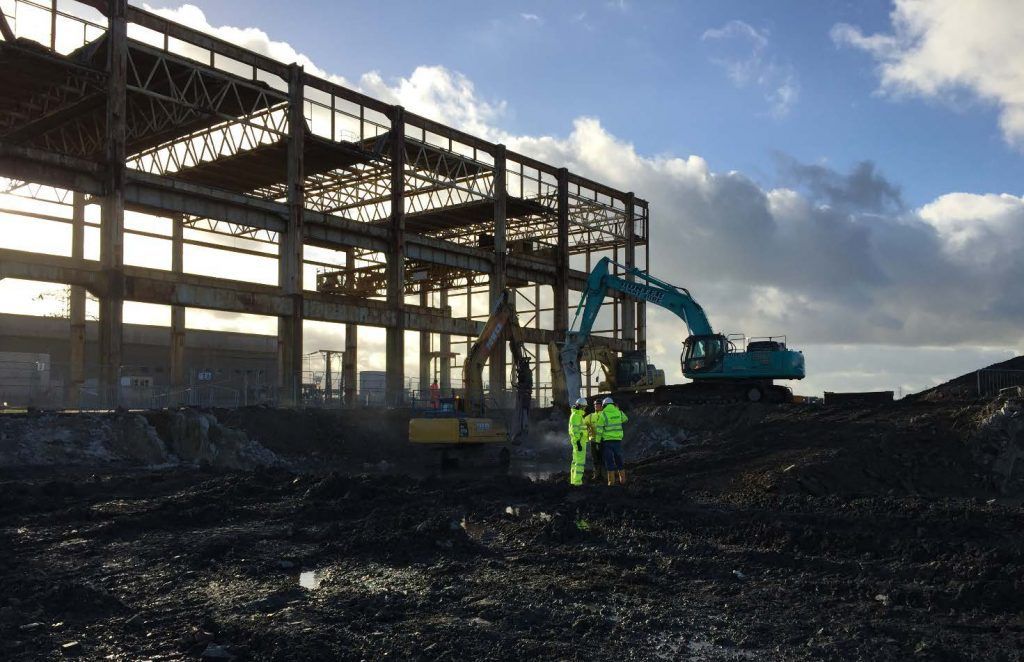Background
The future ‘Richborough Energy Park’ site was originally home to a coal fired power station built in 1958 and commencing power generation from 1963. The low-lying nature of the site, on former marshland meant that 290,000 tons of colliery shale was used to raise site levels ahead of the installation on a labyrinth of heavily reinforced concrete structures, and foundations reaching depths of over 9m. This heavy reinforced construction extended above the ground with buildings formed from heavy gauge steel framework which was clad in aluminium, asbestos containing materials and glass fibre sheets.
In 1971 the power station was converted to burn ‘residual fuel oil’ and required additional heating infrastructure, heavily insulated pipework and additional storage tanks, boilers, and pressurised pumping equipment. The scale of this build was exemplified by two remaining oil storage tanks each measuring more than 44m wide and providing a combined storage capacity of 32,000 tonnes.
This new fuel source significantly increased water requirement such that the adjacent River Stour could not meet the rising demand and a dedicated water treatment plant was commissioned comprising three huge cooling towers with associated pipework and infrastructure. This facility was lined with asbestos sheeting and ancillary products in an attempt to protect it from extreme temperatures.
The multiple chapters in the history of this site created a completely unique combination of chemical processes and contamination sources to a hugely complex and geotechnically compromised site all of left a hugely challenging industrial legacy to resolve for the site to have a viable future.
A Brighter Future
As a result of geographically advantageous proximity to continental Europe the site was identified as a potential receiving station for renewable energy generation. The concept of the ‘Richborough Energy Park’ sought to connect the UK to Belgium via a 130 km long undersea link known as the ‘Nemo Link’. This connection now allows transmission of up to 1000MW between the UK and Europe, as well providing connection to the offshore Thanet Windfarm in a real example of international connectivity.
Scope of Works
The outline scope of works formed a complete enabling works on the 6Ha partially demolished remains of Richborough power station. The project was uniquely offered on an all-risk basis; with only partial site information, no potential for further site investigation and contractual conditions with a ‘consortium of landowners’ meaning that direct discussions with regulators was not possible. This meant that there was only ever one environmental engineering specialist able to meet these challenges. Sanctus were appointed in October 2015 by our Client AECOM on behalf of Siemens Transition Limited for National Grid to deliver this internationally strategic infrastructure project.

Sanctus were tasked with site wide remediation, specialist demolition of remaining structures, clearance of all subsurface obstructions, provision of an engineering platform, treatment of contaminated soils, management of asbestos containing materials, as well as contaminated ground and surface water within the intertidal limits. Each of these individually complicated environmental engineering challenges had to be managed, set against unfavourable local hydrogeology and a unique and highly changeable commercial / political landscape.
Remediation
Sanctus mobilised to site under an agreement that the full site would be available, allowing the soils to be processed outside of the development footprint, maximising the only benefit the site provided (space) to create a streamlined excavation, processing, and reinstatement system. However, upon arrival it became apparent that the majority of the agreed area was unavailable and occupied by additional contractors working on a different phase of the project, reducing our working area from 6ha to 2.5ha. This late change meant that the processing plant had to be redesigned including the plant utilised, sequencing of processes and positioning with respect to the site and other activities on our critical path. This plant operated throughout the programme to treat material on site ensuring that more than 99% of all material was made suitable for beneficial reuse.
A key feature in making the development commercially viable and environmentally appropriate was to achieve virtual complete reuse of material on site. Sanctus’ extensive experience and unparalleled expertise in ground engineering in brownfield environments meant that we could develop a material specification, testing criteria, approach to placement and compaction which maximised reuse and removed the need for expensive and environmentally impactful geotextiles and stabilisation admixtures in the final design. In this way we achieved a closed loop on materials and fully embraced the principles of the circular economy throughout the project.

Specialist Demolition
A large number of surface structures remained on site including individual buildings, the former turbine hall, large steel frames, surface mounted pipework and storage tanks. The specialist demolition of these features required an array of specialist plant ranging from 13t to 71t long reach excavators. The hugely reinforced infrastructure of the former turbine hall was uniquely challenging requiring the use of the largest mechanical breaker in the country (at the time), which could still only achieve in breaking 10m3 of concrete per shift, in a perfect illustration of the structural integrity of the former power station’s construction.
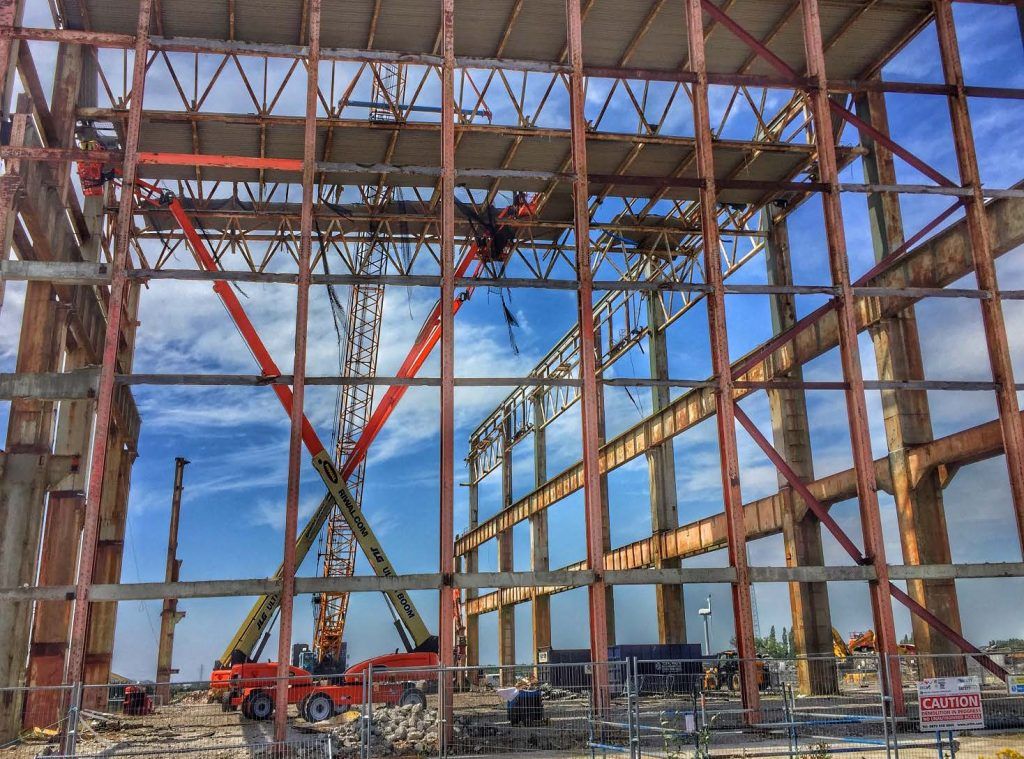
Through the specialist demolition aspects of our works, around 20,000m3 of heavily reinforced concrete slabs, foundations, and foundation piles were recovered and a further 4,000m3 of material from the cooling tower base and associated foundations was broken out and processed for beneficial use.
Subsurface Obstruction Removal
One of the key deliverables for the project was the turnover of the development area to 2.4m AOD, with all soils being screened to remove any oversize materials. It was during this part of the project where the extent of missing information became clear as multiple cavernous interconnected, reinforced basements were discovered. This meant that specialist confined spaces procedures had to be implemented to allow the basements to be accessed and surveyed. Having determined that these areas contained ACMs, Sanctus produced detailed plans of work and submitted a notification to the HSE ahead of undertaking licensed removal works.
All below ground structures within the designated site boundary were broken out to the agreed level of 2.4m AOD, with large footings and structures removed in their entirety. Historically, more than 4,000 piles were used in the construction of the power station meaning they were ubiquitous across previously developed areas. Where impracticable to remove, few piles were left once the ground was reduced to level, in agreement with the clients’ design team. This allowed them to adjust their foundation design based on the known residual ground risk across the site, providing some structural advantages over full scale removal.
Materials were screened for visual and olfactory contamination and argillaceous (clay based) materials removed and processed into general fills/engineering materials. All oversize material was again processed and reengineered to form compliant fill.

Civil Engineering Solutions
The demolition and obstruction removal works extended only to the edges of the development boundary. Adjacent to the southern boundary transformers was the basement for the former turbine hall. The client requested that the basement be sealed at the CDM boundary and kept in situ where possible rather than being broken out or fully infilled.

Working within very specific technical parameters, Sanctus engineered a unique gabion basket solution adjacent to where the existing basement walls were exposed. This gabion wall was ~4m high and 3m wide at is base, which supported and offloaded the remaining foundations of the basements. This provided security to the client ensuring the site boundary was resilient even if basement structures were removed outside of the site boundary at a later date. The gabion baskets allowed for a full reinstatement of the area up to the site boundary and met the hugely demanding load tolerance requirements.
Some remaining below ground structures also underlay transit routes across site and therefore required significant remedial works to stabilise them to prevent collapse during the importation of large items, during the construction phases of the project. The remaining substantial cooling pipes, some 2.5m in diameter and 300m in combined length, running beneath the area of the original turbine hall were removed up to the CDM boundaries and near to sensitive structures.
Where pipe work could not be removed they were filled with an expanding ‘Bacel’ Resin Foam. The sealing of pipes was undertaken sequentially using modular reusable formwork to ensure optimal filling and density removing future risk of compaction. The particular resin was selected for its resistance to residual contamination and salt water from the tidal influences. The pipes being up to 2.5m in diameter were weighed down and strapped to concrete mass foundations up to 5mbgl, during pipe removal and infilling, all works were undertaken under confined space controls with all operatives equipped with respirators and gas detectors to ensure safe working practices.
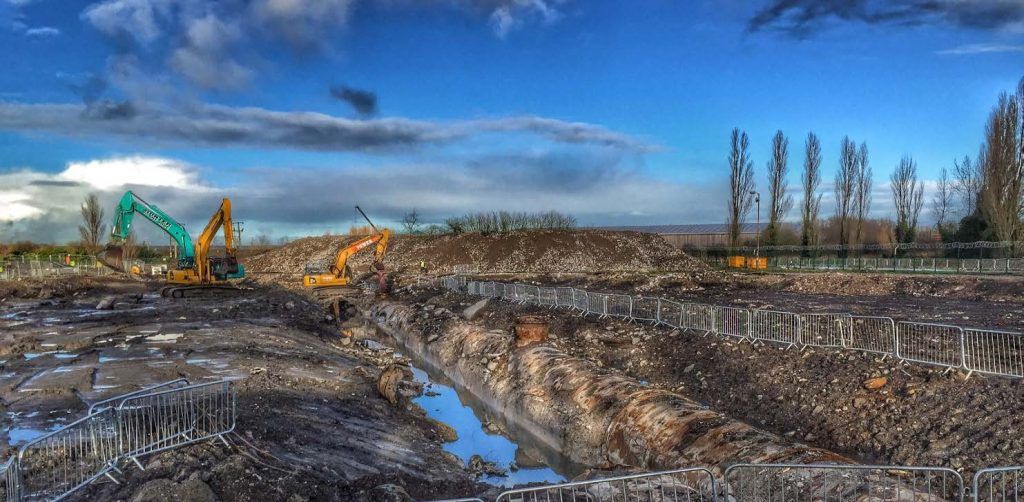
A by-product of the use of this resin was the release of formaldehyde into the residual waters present in the base of the pipe. Sanctus used Air-Sparing to force the formaldehyde out of solution as well as passing the water through granular activated carbon pods as part of our water treatment operation, removing residual risk. Additional liquid gross contamination from the residual products in the pipelines was encountered as result of this sparging, which was removed to a specialist treatment facility, via a suitably licensed haulier.
This combination of ground and civil engineering interventions was hugely important as the solution allowed record-breaking vehicle movements and plant to safely transit across the site border, including what was at the time the largest (by weight) import and road going delivery in the UK. Eventually four power converters were delivered fully assembled to site on a 28-axel lorry over Sanctus’ retaining structure and reengineered ground improvements.
Soil Treatment
A large component of the soil improvement works involved removing argillaceous (clay rich rocks) material from site won fill and pre-processing it to reduce its compressibility. The screening, crushing and improvements turned the problematic waste material into a competent fill, achieving a minimum of 5% CBR. This over performance of the material allowed Sanctus to reduce thickness of the pile mat, which provided additional value engineering. Sanctus were able to virtually remove the need to import material, achieving significant financing and environment improvement. Sanctus were able to process and re-engineer 65,000m3 of material to or above the client’s original specification – achieving 5% CBR at formation and 10% for the piling mat.
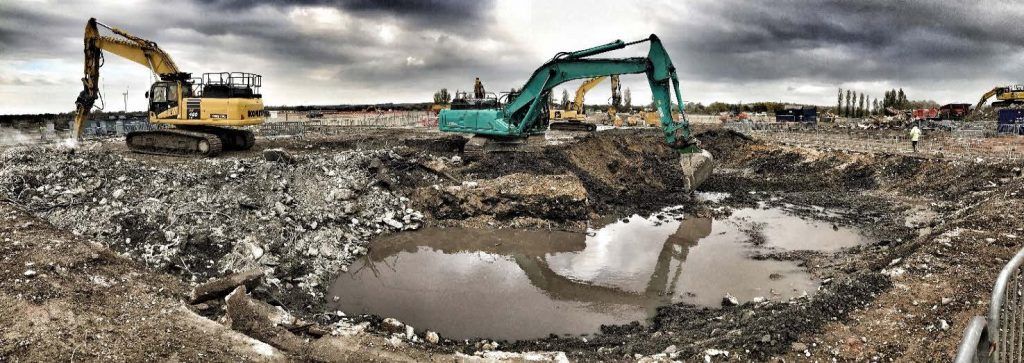
Asbestos Management
Asbestos containing materials were prevalent across much of the development, therefore Sanctus opted to process contaminated soils on site allowing them to be reused in accordance with the clients’ specification (reuse at depth). This process comprised the excavation of all soils found to contain asbestos within the CDM boundary, to be passed over to a picking station where specially trained and experienced operatives handpicked and removed asbestos fragments from the soils. This careful and skilled hand-picking exercise allowed virtually all soils to be retained on site with only bulk asbestos containing materials and impacted PPE picked being disposed of offsite. Confirmation of the effectiveness of this processing was verified by a watching brief for material placement and the recovery of validation soil samples independently tested by UKAS accredited laboratories which demonstrated that the remaining samples no longer contained fragments of asbestos.
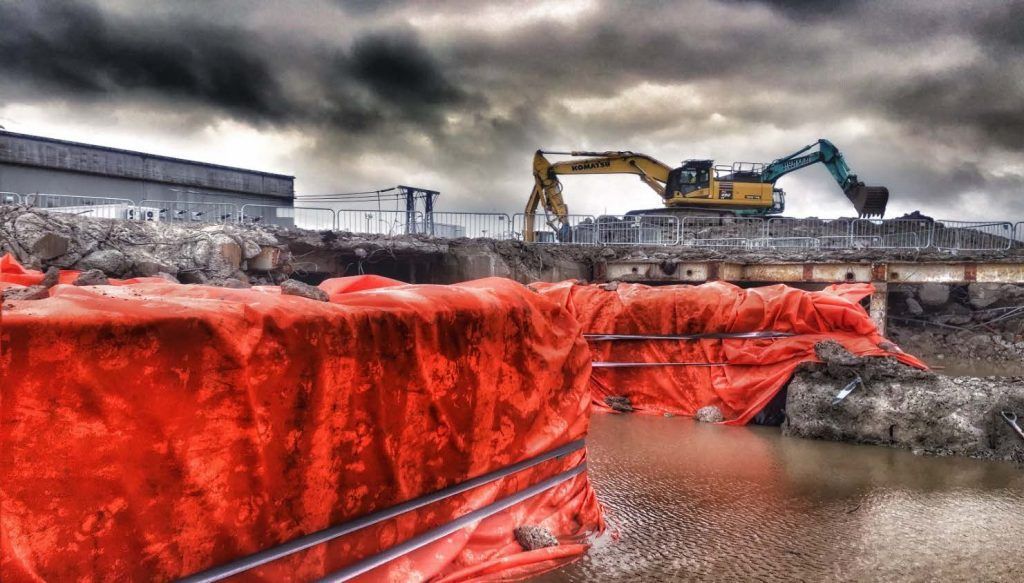
Water Treatment
As the site was founded on former tidal flats, dewatering, water treatment and management were defining features of the works. Unfortunately, due to the commercial / political landscape of the project Sanctus were unable to engage in advanced permitting discussions with regulators which could have caused significant permitting delays. Sanctus therefore developed a dewatering solution, temporarily holding water within the site allowing vital works to progress without delay.
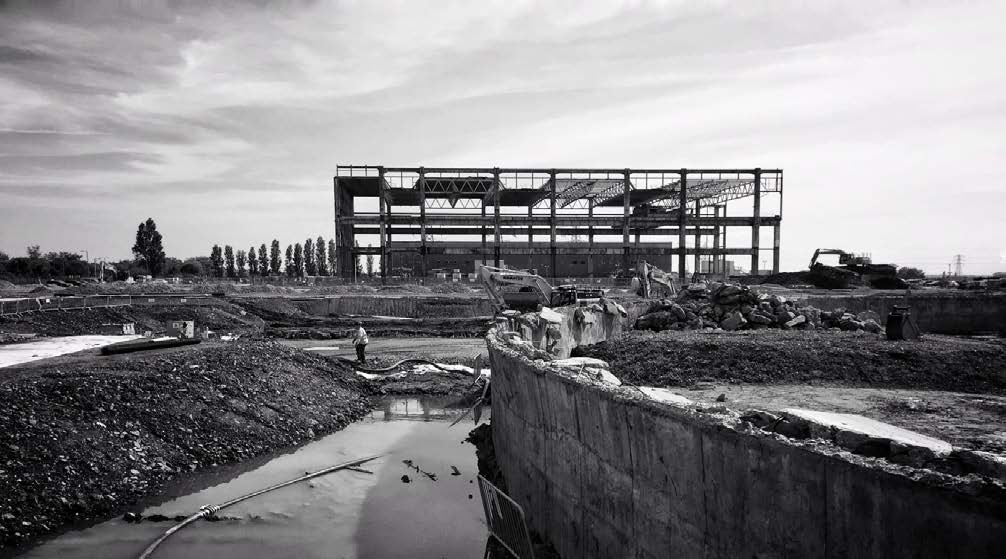
The relic structures from the former cooling tower bases were repurposed as temporary reservoirs to store treated water until a discharge consent was granted. The cooling tower bases were surveyed, determined to be watertight and cleared of asbestos containing materials before providing 6000m3 of temporary water storage. Once the discharge consent to the tidally impacted main river was granted, under the conditions of a falling tide, water was pumped across site and passed through our bespoke parallel series of water treatment plant comprising of oil water separators, clarifiers and granular activated carbon pods.
Across the programme this allowed Sanctus to treat and safely release nearly 19,000,000 litres of water into the River Stour with the discharge monitored throughout demonstrating that we successfully achieved an environmental betterment.

Material Reuse – Application of the Circular Economy
The only materials to leave site during the project were non-recyclable materials considered unsuitable for reuse including materials that would degrade over time such as wood and vegetation and bulk asbestos products and PPE.
All concrete broken out was recycled on site to a minimum 6F2 grading allowing it to be reused on site, hugely decreasing the volume of aggregates required to be imported to site to form the 25,000m2 piling mat
The overall cut and fill earthworks comprised re-use of 69,000m3 material (45,000m3 of Made Ground and 24,000m3 of site won recycled aggregate).

Environment Protection and Improvement
Throughout the works, extensive and varied environmental monitoring was carried out to ensure no uncontrolled emissions occurred. This included ongoing water quality monitoring as well as reassurance air monitoring around the perimeter of all asbestos works.
Ahead of our works, concerns were raised regarding the potential level of vibration that would be caused by the demolition activities. Sanctus therefore placed high sensitivity vibration monitors at key locations across the site and monitored frequently to ensure and demonstrate there was limited risk of effecting the adjacent transformers to the immediate south of the site. Added to this further monitoring systems and inspections were used during the installation and loading of the bespoke gabion structures and remaining basement structures on the CDM boundary.
Additional monitoring and protection measures were also implemented during higher risk activities such as throughout sub surface works where operatives were fitted with real time multi gas monitoring equipment and alarm systems in addition to asbestos controls. All of which demonstrated that the controls being implemented by Sanctus were suitable to protect people, wildlife, and the environment.
Conclusion
The works carried out by Sanctus allowed the development of one of the most industrially impacted sites on the east coast. This previously derelict parcel of land formerly used as a coal and oil-fired power station should never have been recovered as it was simply not technically possible, commercially viable or environment suitable to do so. These are the exact challenges that motivate Sanctus.
As a result of our all-risk approach to contracting, the site has been transformed into a glowing example of international connectivity and cooperation, providing a strategically significant infrastructure asset for the country. By reusing virtually all materials on site Sanctus was able to make the development commercially viable but perhaps more importantly environmentally appropriate. The small volume of materials leaving site were able to be recycled and where possible, sent to local facilities for repurposing. The only unrecoverable materials comprised degradable vegetation/timber and bulk asbestos. It was especially pleasing to achieve a betterment to the local water environment through our treatment of groundwater impacted by decades of contamination.
Throughout our time on site Sanctus were able to adapt to an ever-changing commercial and political situation managing to complete the works to the required standards on budget and within the final programme.
Since completion and demobilisation, Sanctus have not been required to return to site to rectify any issues and the development project was completed, going online in January 2019. As a result, we are delighted that we can now openly and publicly talk about this once in a lifetime brownfield project.
